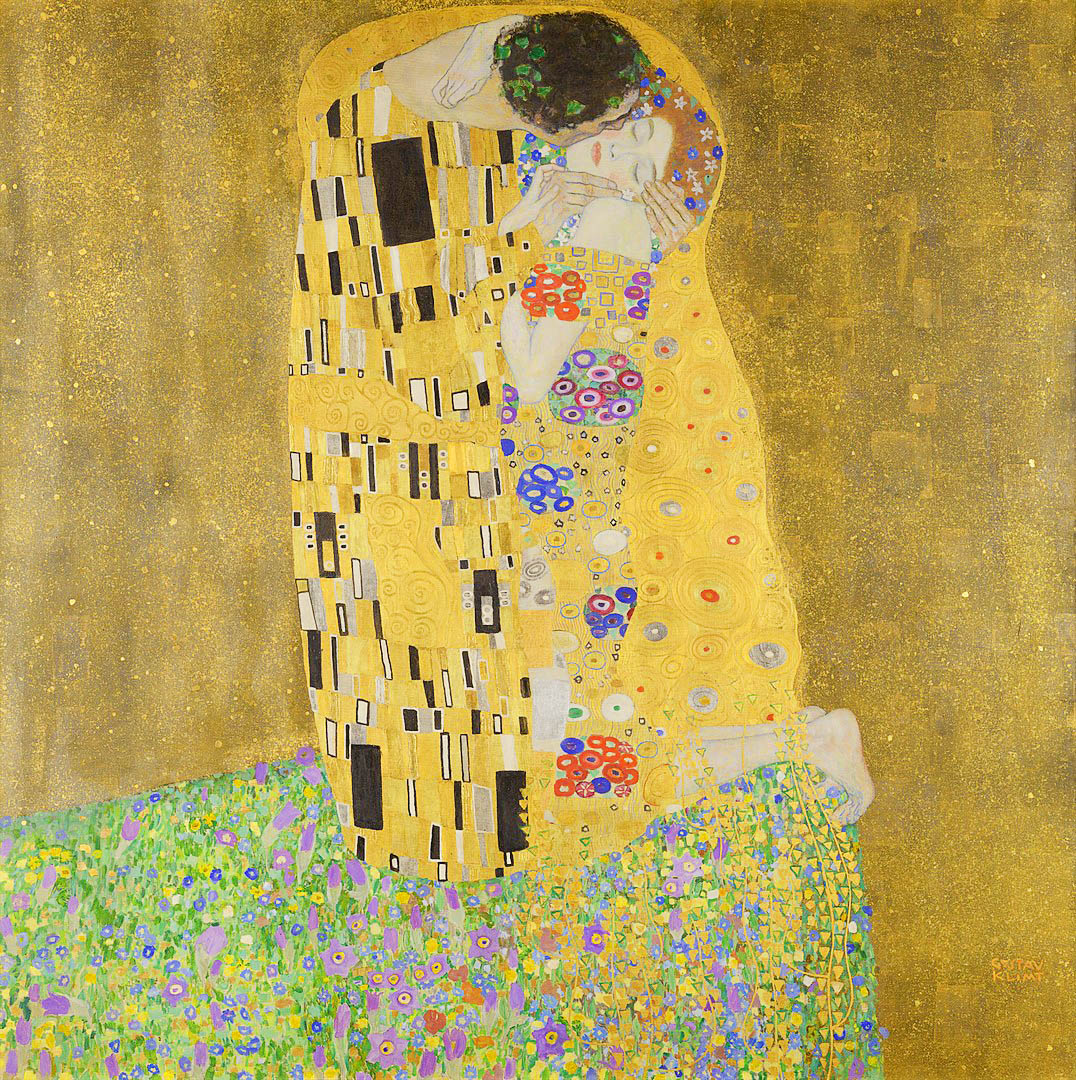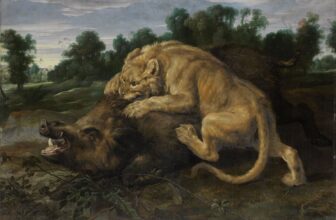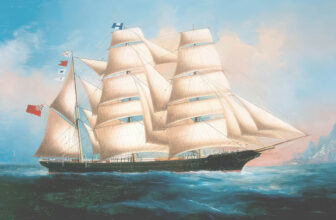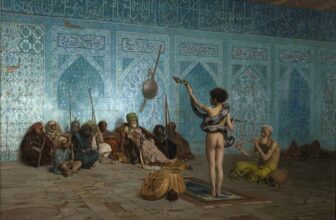
What is the The Meaning of The Kiss Painting by Gustav Klimt
Gustav Klimt’s The Kiss (1907–1908) is one of the most iconic and celebrated works of the early 20th century. Painted during Klimt’s “Golden Phase,” the artwork is rich with symbolism, emotion, and intricate beauty. At its core, The Kiss explores themes of love, intimacy, transcendence, and the unity of masculine and feminine energies, all conveyed through Klimt’s distinctive style, blending symbolism, Art Nouveau, and Byzantine influences.
The painting depicts a man and a woman locked in a tender embrace. The man leans forward to kiss the woman, who appears to surrender herself completely to the moment, eyes closed, her body encircled by his protective form. They are wrapped in elaborate, golden robes, merging into a single, unified shape that blurs the boundary between their individual identities. This fusion is one of the painting’s central ideas: the complete surrender of the self within romantic love. The couple appears to exist in a timeless, ethereal space, removed from the world and suspended in a moment of pure emotional intensity.
One of the most striking aspects of The Kiss is Klimt’s use of gold leaf, which adds a spiritual, almost divine aura to the scene. This use of gold draws inspiration from Byzantine religious art, especially mosaics Klimt studied during a visit to Ravenna, Italy. By combining religious iconography with sensual human figures, Klimt elevates romantic and erotic love to a sacred plane. The shimmering gold enhances the sense that the couple is enveloped in a sacred space, where physical and spiritual love converge.
The symbolism in the clothing is also significant. The man’s robe is decorated with geometric, rectangular forms, traditionally interpreted as representing masculinity. In contrast, the woman’s gown is adorned with flowing circles and floral motifs, evoking femininity, softness, and fertility. These opposing forms are harmoniously intertwined, suggesting the balance of male and female forces—a common theme in Symbolist art and philosophy.
Despite the painting’s romanticism, it also contains a subtle tension. The woman’s posture is often interpreted in different ways: is she submitting to the kiss in ecstasy, or is there a sense of resignation or even reluctance? This ambiguity invites viewers to reflect on the complexities of love and intimacy. Klimt does not offer a simple, idealized view of romance but instead presents a layered, emotionally charged moment that captures both vulnerability and desire.
Created during a time of great social and artistic change in Vienna, The Kiss also reflects broader cultural themes. The early 20th century was a period of deep psychological exploration, influenced by Freud and the rise of modernist thought. Klimt, associated with the Vienna Secession movement, sought to break away from academic traditions and explore human emotion, sexuality, and the unconscious through art.
The Kiss is a profound meditation on love as both a physical and spiritual union. Through his lavish use of gold, symbolic motifs, and emotional intensity, Klimt offers viewers a timeless representation of passion, unity, and the transcendent nature of human connection. It remains a masterpiece not only for its beauty but for its deep psychological and symbolic resonance.
The Story Behind The Kiss
Some paintings have captured the world’s imagination quite like The Kiss by Gustav Klimt. This mesmerizing artwork, painted between 1907 and 1908, is an icon of love, passion, and artistic brilliance. But what is the story behind The Kiss? Why is it so famous? This article will explore the fascinating history, symbolism, controversies, and lasting legacy of Klimt’s masterpiece.
Gustav Klimt was an Austrian Symbolist painter and one of the most prominent members of the Vienna Secession movement. By the early 20th century, he had gained a reputation for his sensual and often provocative works, many of which were deemed scandalous by the conservative Viennese society. His fascination with themes of love, eroticism, and the divine is evident in The Kiss, which is widely regarded as the pinnacle of his “Golden Period.”
During this time, Klimt extensively used gold leaf in his paintings, influenced by Byzantine mosaics he had seen during a trip to Ravenna, Italy. The Kiss was created at a turning point in his career, following heavy criticism of his earlier works, particularly his ceiling paintings for the University of Vienna, which were condemned as too erotic and inappropriate for academic settings. The Kiss, however, struck a perfect balance between sensuality and transcendence, making it one of Klimt’s most beloved and commercially successful works.
Why Is The Kiss So Famous?
There are several reasons why The Kiss has achieved such widespread fame:
1. Its Universal Theme of Love and Passion
At its core, The Kiss represents love in its purest and most intense form. The embrace between the two figures, a man and a woman, is depicted with an almost dreamlike intimacy. The lovers seem to exist in their own world, disconnected from time and space, conveying the overwhelming power of love and connection. This universal theme resonates deeply with viewers across different cultures and generations.
2. The Use of Gold and Decorative Patterns
Klimt’s use of gold leaf, combined with elaborate patterns and textures, creates a sense of opulence and mysticism. The painting shimmers with an otherworldly glow, making it stand out in any gallery or reproduction. This signature style, inspired by Byzantine and medieval art, gives The Kiss a timeless and iconic quality.
3. Its Sensual Yet Subtle Eroticism
Unlike Klimt’s more explicitly erotic works, such as Danaë or The Beethoven Frieze, The Kiss manages to be both sensual and romantic without being overtly sexual. The way the man holds the woman’s face while pressing a tender kiss on her cheek, and the way she tilts her head in surrender, evoke an intense yet delicate expression of passion.
4. Its Cultural and Artistic Significance
As a masterpiece of the Vienna Secession movement, The Kiss embodies the transition from 19th-century academic art to modernism. Its innovative use of gold, pattern, and abstraction influenced generations of artists and continues to be celebrated as one of the greatest works in art history.
What Does Gold Symbolize in The Kiss?
Gold plays a crucial symbolic role in The Kiss. Klimt’s extensive use of gold leaf not only enhances the painting’s visual appeal but also carries deep meanings:
1. A Connection to Byzantine Art
Klimt was inspired by the gold mosaics of Ravenna’s churches, particularly in San Vitale. The use of gold in religious art historically represented the divine, the eternal, and the transcendent. By incorporating gold in The Kiss, Klimt elevates love to something almost sacred and eternal.
2. The Materialization of Passion
The gold enveloping the lovers suggests that their love is precious, rare, and valuable, akin to a treasure. The golden patterns on their robes reinforce the idea that love is both intricate and extraordinary.
3. A Symbol of Artistic Liberation
During the Vienna Secession, artists sought to break free from traditional artistic norms. Klimt’s use of gold was both a technical innovation and a rebellious statement against academic realism, embracing modernist abstraction and symbolism.
Why Is The Kiss Considered a Masterpiece?
1. A Perfect Balance of Form and Emotion
Klimt masterfully blends figuration with abstraction. While the faces and hands of the lovers are rendered with delicate realism, their bodies dissolve into elaborate, decorative patterns. This unique composition creates a harmonious balance between the tangible and the ethereal.
2. An Emblem of the Art Nouveau Movement
Art Nouveau emphasized organic forms, intricate patterns, and fluid lines. The Kiss is one of the best examples of this style, with its curvilinear shapes, floral motifs, and elaborate ornamentation.
3. Its Psychological Depth
Beyond its visual beauty, The Kiss conveys deep psychological and emotional intensity. The posture of the figures, one firmly embracing, the other surrendering, suggests themes of unity, desire, and even vulnerability.
4. Timeless Appeal
Despite being over a century old, The Kiss continues to captivate audiences worldwide. Its themes of love and human connection make it relevant to every generation, ensuring its enduring popularity.
The Controversy Surrounding The Kiss
While The Kiss is widely adored today, Klimt himself was a controversial figure. His works often sparked debates due to their sensual and erotic nature. Some critics at the time accused him of being too focused on sexuality, while others viewed his art as revolutionary.
One specific controversy related to The Kiss is whether it was inspired by a real-life romance. Some art historians speculate that the woman in the painting was Emilie Flöge, Klimt’s longtime companion and muse. Others believe it was simply an idealized depiction of love rather than a personal statement.
Additionally, Klimt’s art was targeted by the Nazi regime, which deemed his works “degenerate art.” Many of his paintings were confiscated, and some, unfortunately, were lost forever. Fortunately, The Kiss survived and remains one of Austria’s greatest cultural treasures.
Where Is The Kiss Located Today
The Kiss is currently housed in the Belvedere Palace Museum in Vienna, Austria. It is one of the most treasured pieces in the museum’s collection and draws thousands of visitors each year. The Belvedere Palace itself is a historical landmark, adding to the painting’s mystique and allure.
Gustav Klimt’s The Kiss is more than just a painting; it is a timeless representation of love, passion, and artistic genius. Its use of gold, intricate patterns, and emotional depth make it one of the most famous and beloved paintings in the world. Despite past controversies, its legacy endures, cementing Klimt’s place as one of the greatest artists of all time. If you ever have the chance to visit Vienna, seeing The Kiss in person at the Belvedere Palace is an unforgettable experience, a moment of artistic magic that continues to inspire and enchant.
No matter how many times one gazes at The Kiss, its beauty never fades, like true love, it remains eternal.




